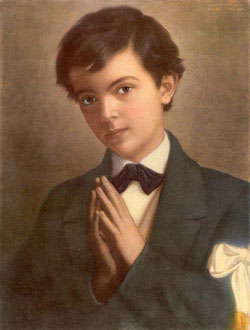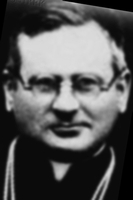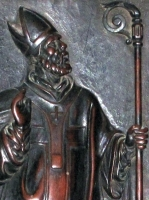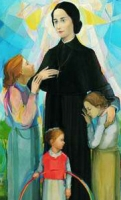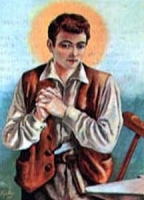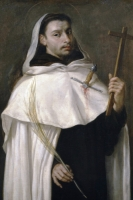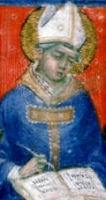St. Dominic Savio
புனிதர் டோமினிக் சாவியோ
ஒப்புரவாளர்:
(Confessor)
பிறப்பு: ஏப்ரல் 2, 1842
சான் ஜியோவன்னி, ரிவா ப்ரெஸோ சியரி,
பைட்மான்ட், இத்தாலி
(San Giovanni, Riva presso Chieri, Piedmont, Italy)
இறப்பு: மார்ச் 9, 1857 (வயது 14)
மொன்டொனியோ, பைட்மான்ட், இத்தாலி
(Mondonio, Piedmont, Italy)
ஏற்கும் சமயம்:
கத்தோலிக்க திருச்சபை
(Roman Catholic Church)
எபிஸ்கோபல் திருச்சபை
(Episcopal Church)
அருளாளர் பட்டம்: மார்ச் 5, 1950
திருத்தந்தை 12ம் பயஸ்
(Pope Pius XII)
புனிதர் பட்டம்: ஜூன் 12, 1954
திருத்தந்தை 12ம் பயஸ்
(Pope Pius XII)
முக்கிய திருத்தலங்கள்:
கிறிஸ்தவர்களின் சகாய அன்னை பேராலயம்,
தூரின், இத்தாலி
(The Basilica of Mary Help of Christians in Turin)
நினைவுத் திருவிழா: மே 6
பாதுகாவல்:
பீடச்சிறார், பாடகர் குழுச் சிறார், இளம் குற்றவாளிகள்,
தவறுதலாக குற்றம் சுமத்தப்பட்டோர்
புனிதர் டோமினிக் சாவியோ, இத்தாலியைச் சார்ந்த புனித ஜான் போஸ்கோவின் வளரிளம் பருவ மாணவர்களில் ஒருவர் ஆவார். இவர் குருவாகும் ஆசையில் படித்துக் கொண்டிருந்தபோது தமது 14ம் வயதில் “நுரையீரல் அழற்சி” (Pleurisy) நோய் பாதிக்கப்பட்டு இறந்தார்.
பதினான்கு வயதே நிரம்பிய டோமினிக் சாவியோவின், தீரம் நிறைந்த அன்றாடப் புண்ணிய வாழ்வே இவரைப் புனிதர் நிலைக்கு உயர்த்தியது. கத்தோலிக்க திருச்சபையில் மறைசாட்சியாக இறக்காத புனிதர்களில் இவரே மிகவும் இளையவர்.
தொடக்க காலம்:
வீட்டு வாழ்வு:
டோமினிக் சாவியோ, 1842ம் ஆண்டு, ஏப்ரல் மாதம், 2ம் தேதியன்று, வட இத்தாலியின் “பியெட்மோன்ட்” (Piedmont) பிராந்தியத்திலுள்ள “சியரி” (Chieri) நகரின் அருகேயுள்ள “ரிவா” (Riva) எனும் கிராமத்தில் பிறந்தார். இவர் சிறுவயதில் இருந்தே இயேசுவிடமும், அன்னை மரியாளிடமும் மிகுந்த பக்தி கொண்டிருந்தார். இவரது குடும்பமும் சூழ்நிலையும் இவரை புனிதத்தில் வளர்த்தன. இவரது பெற்றோர் இவரை கிறிஸ்தவ மதிப்பீடுகளில் வளர்ப்பதில் அதிக ஆர்வம் காட்டினர்.
நான்கு வயதிலேயே தனியாக செபிக்கும் திறமை பெற்றிருந்த சாவியோ, தான் முதல் நற்கருணை பெற்ற நாளைப் பற்றிக் குறிப்பிடும்போது, "என் வாழ்வின் மிகவும் மகிழ்ச்சியானதும் அற்புதமானதுமான நாள் அது" என்கிறார். இவர் ஆலயத்தின் பீடச் சிறுவர்கள் குழுவில் இணைந்து திருப்பலியில் குருக்களுக்கு உதவி செய்தார்; அதிகாலை 5 மணிக்கே ஆலயம் சென்றுவிடும் வழக்கத்தைக் கொண்டிருந்தார். மழையிலும், குளிரிலும் இவர் ஆலயத்திற்கு தவறாமல் சென்றார்.
ஆரட்டரியில்:
12 வயதில் கடவுளின் அழைப்பை உணர்ந்து, புனிதர் ஜான் போஸ்கோ (Saint John Bosco) நடத்திய ஆரட்டரியில் சாவியோ சேர்ந்தார். 1854ம் ஆண்டு, அக்டோபர் மாதம், முதல் திங்கட் கிழமை, தனது தந்தையுடன் புனிதர் ஜான் போஸ்கோவை சந்தித்த இவர், “நான் தைக்கப்படாத துணியாக இருக்கிறேன், என்னை இயேசுவுக்கு உகந்த நல்ல சட்டையாகத் தைப்பது உங்கள் பணி” என்று அவரிடம் கூறினார்.
கெட்ட வார்த்தைகள் பேசிய சிறுவர்களை சாவியோ கண்டித்து திருத்தினார்; சண்டையிட்டுக் கொண்ட சிறார்களுக்கிடையே சமாதானம் செய்துவைத்தார். தீய வழிகளில் இருந்து விலகி, களங்கமற்ற தூய்மையான புண்ணிய வாழ்வு வாழ்ந்தார். தனது செயல்கள் அனைத்தையும் இறைவனின் புகழ்ச்சிக்காகவே செய்து வந்தார்.
குருத்துவ படிப்பு:
இறுதியில் சாவியோ குரு மடத்தில் சேர்ந்தார். ‘பாவம் செய்வதை விட சாவதே மேல்’ என்பது இவரது விருதுவாக்கு ஆகும். 14ம் வயதில் இவருக்கு உடல் நலம் பாதிக்கப்பட்டதால் மிகவும் பலவீனம் அடைந்தார். 1857ம் ஆண்டு, மார்ச் மாதம், 9ம் தேதி, விண்ணகக் காட்சியால் பரவசம் அடைந்து, “ஆகா, எவ்வளவு இன்பம் நிறைந்த அற்புத காட்சி!” என்று கூறியவாறே டோமினிக் சாவியோ உயிர் துறந்தார்.
டோமினிக் சாவியோ மரித்ததும் புனிதர் ஜான் போஸ்கோ இவரது வாழ்க்கை வரலாற்றை புத்தகமாக எழுதினார். அது இவரது புனிதர் பட்டமளிப்பு நடவடிக்கைகளில் முக்கிய ஆதாரமாக விளங்கியது.
புனிதர் பட்டம்:
சாவியோவின் புனிதர் பட்டத்திற்கான நடவடிக்கைகளைத் தொடங்கிவைத்த திருத்தந்தை 10ம் பயஸ் (Pope Saint Pius X), “தோமினிக் என்னும் இளைஞர், திருமுழுக்கில் பெற்ற புனிதத்தைப் பழுதின்றி காப்பாற்றிக் கொண்டவர்" என்று இவரைப் புகழ்கின்றார்.
1933ல் இவருக்கு வணக்கத்திற்குரியவர் பட்டம் வழங்கிய திருத்தந்தை 11ம் பயஸ் (Pope Pius XI), “தூய்மை, பக்தி, ஆன்மீகத் தாகம் ஆகியவற்றின் ஆற்றலால் சாவியோவின் கிறிஸ்தவ வாழ்வு நமக்கு முன்மாதிரியாக உள்ளது” என்று கூறுகிறார்.
திருத்தந்தை 12ம் பயஸ் (Pope Pius XII), டோமினிக் சாவியோவுக்கு 1950ம் ஆண்டு, மார்ச் மாதம், 5ம் நாளன்று, அருளாளர் பட்டமும், 1954ம் ஆண்டு, ஜூன் மாதம், 12ம் தேதியன்று, புனிதர் பட்டமும் வழங்கி உரை நிகழ்த்தியபோது, “இளைஞர்கள் சாவியோவின் வழிகளைப் பின்பற்ற வேண்டும். தீய சக்திகளின் தாக்கங்களைப் புறக்கணித்து, தூய்மையில் நிலைத்து நின்ற சாவியோவின் புனித வாழ்க்கை இளைஞர்களுக்கு சிறந்த எடுத்துக்காட்டு” என்று கூறினார்.
Feastday: May 6
Birth: April 2, 1842
Death: March 9, 1857
Beatified: March 5, 1950 by Pope Pius XII
Canonized: June 12, 1954 by Pope Pius XII
Dominic Savio was born on April 2, 1842 in the village of Riva in northern Italy. His father was a blacksmith and his mother a seamstress. He had nine brothers and sisters. His family was poor but hardworking. They were devout and pious Catholics.
When he was just two years old, Dominic's family returned to their native village of Castlenuovo d'Asti, (Today, Castlenuovo Don Bosco) near the birthplace of John Bosco. Bosco would himself later be canonized as a Saint by the Church and became a major influence on the life of Dominic.
As a small child, Dominic loved the Lord and His Church. He was very devout in practicing his Catholic faith. For example, he said grace before every meal and refused to eat with those who did not. He was always quick to encourage others to pray.
Dominic attended Church regularly with his mother and was often seen kneeling before the Tabernacle in prayer. He even prayed outside the Church building. It did not matter to Dominic if the ground was covered with mud or snow, he knelt and prayed anyway.
Dominic was quickly recognized as an exceptional student who studied hard and performed well in school. He became an altar server. He also attended daily Mass and went to confession regularly. He asked to receive his first communion at the age of seven. This was not the practice in the Church of Italy at the time. Normally, children received their first holy communion at the age of twelve. Dominic's priest was so impressed with his intelligence concerning the faith, his love for the Lord and his piety that he made an exception. Dominic said that the day of his First Communion was the happiest day of his life.
On the Day he received his first communion, Dominic wrote four promises in a little book. Those promises were:
I will go to Confession often, and as frequently to Holy Communion as my confessor allows.
I wish to sanctify the Sundays and festivals in a special manner.
My friends shall be Jesus and Mary.
Death rather than sin.
The young Dominic graduated to secondary school and walked three miles to school each day. He undertook this chore gladly. While walking to school on a hot day a farmer asked why he wasn't yet tired. Dominic cheerfully replied, "Nothing seems tiresome or painful when you are working for a master who pays well."
Although he was young, Dominic was clearly different than his peers. When two boys stuffed a school heating stove with snow and rubbish. The boys were known troublemakers and were likely to face expulsion if caught, so they blamed Dominic for the misdeed. Dominic did not deny the accusation and he was scolded before the class. However, a day later the teacher learned the truth. He asked Dominic why he did not defend himself while being scolded for something he did not do. Dominic mentioned he was imitating Jesus who remained silent when unjustly accused.
Dominic's teacher spoke well of him and brought him to the attention of Fr. John Bosco, who was renowned for looking after hundreds of boys, many of them orphaned and poor. In October 1854, Dominic was personally introduced to Fr. Bosco - along with his father.
At the meeting, Bosco wanted to test Dominic's intelligence and understanding of the Catholic faith. He gave Dominic a copy of The Catholic Readings, which was a pamphlet that dealt with apologetics. He expected Dominic to provide a report the next day, but just ten minutes later Dominic recited the text and provided a full explanation of its significance. This solidified Bosco's high opinion of Dominic.
Dominic expressed an interest in becoming a priest and asked to go to Turin to attend the Oratory of St. Francis de Sales. Fr. Bosco agreed to take him.
At the Oratory, Dominic studied directly under Fr. Bosco. He worked diligently and always asked questions when he did not understand something. He renewed his First Communion promises that he wrote in his little book at the age of seven. After six months at the Oratory, Dominic delivered a speech on the path to sainthood. In his speech, he made three outstanding points; it is God's will that we ALL become saints, it is easy to become a saint, and there are great rewards in heaven for saints.
Dominic's desire to become a saint troubled him however. He wondered to himself how someone as young as he was could become a saint? In his zeal, he tried voluntary mortification and other voluntary penances, hoping that they would help him to grow closer to Jesus and help him to be less concerned with his own needs. He even made his bed uncomfortable and wore thin clothes in winter. When Fr. Bosco observed these practices, he corrected Dominic. He explained that as a child, what he should do instead was to devote himself to his studies and to be cheerful. He discouraged Dominic from any more physical penances. Dominic's happy demeanor quickly returned.
At the same time Dominic was developing his reputation as a fantastic student, his health began to fail. He started to lose his appetite and Fr. Bosco became concerned. Dominic was taken to the doctor who recommended that he be sent home to his family to recover. Dominic wanted to stay at the oratory, but Fr. Bosco insisted he go home. Everybody expected Dominic to recover, except for Dominic himself who insisted he was dying.
Before he departed, Dominic made the Exercise of a Happy Death and predicted this would be his final devotion.
After four days at home, Dominic's health worsened. The doctor ordered him to bed to rest. He then performed bloodletting, which was still performed at that time. Over the next four days, Dominic was bled ten times before the doctor was satisfied he would recover.
But Dominic was sure of his impending death. He implored his parents to bring the parish priest so he could make a last confession. They obliged him and Dominic made a confession and was given the Anointing of the Sick. He asked his father to read him the prayers for the Exercise of a Happy Death. Then he fell asleep. Hours later he awoke and said to his father: "Goodbye, Dad, goodbye ... Oh what wonderful things I see!" Dominic fell asleep and died within minutes. It was March 9, 1857 and Dominic was merely 14 year of age.
His father wrote to Fr. Bocso to report the sad news.
Fr. Bosco was powerfully touched by Dominic and he wrote a biography, "The Life of Dominic Savio." The biography quickly became popular and would eventually be read in schools across Italy. As people learned about Dominic, they called for his canonization.
Detractors argued that Dominic was too young to be canonized and pointed out that he was not a martyr. However, Pope Pius X disagreed and opened his cause for canonization.
Dominic Savio was declared venerable in 1933 by Pope Pius XI, beatified in 1950, then canonized in 1954 by Pope Pius XII.
Saint Dominic is the patron saint of choirboys, the falsely accused, and juvenile delinquents. His feast day is May 6, moved from March 9. Many schools and institutions dedicated to boys are dedicated to him.
Dominic Savio (Italian: Domenico Savio; 2 April 1842 – 9 March 1857) was an Italian student of Saint John Bosco. He was studying to be a priest when he became ill and died at the age of 14, possibly from pleurisy.[5] He was noted for his piety and devotion to the Catholic faith, and was eventually canonized.
Bosco regarded Savio very highly, and wrote a biography of his young student, The Life of Dominic Savio. This volume, along with other accounts of him, were critical factors in his cause for sainthood. Despite the fact that many people considered him to have died at too young an age – fourteen – to be considered for sainthood, he was considered eligible for such singular honour on the basis of his having displayed "heroic virtue" in his everyday life.[6] Savio was canonised a saint on 12 June 1954, by Pope Pius XII, making him the youngest non-martyr to be canonised in the Catholic Church[7] until the canonisations of Francisco and Jacinta Marto, the pious visionaries of Fatima, in 2017.
Saint John Before the Latin Gate
About the Feast
Commemorates the attempted martyrdom of Saint John the Apostle in 95. John was bound and brought to Rome, Italy from Ephesus by the order of Domitian; the Senate condemned him to be taken to the Latin Gate and thrown in a cauldron of boiling oil. John stepped out of the cauldron without injury, and instead was exiled to Patmos.
Blessed Anna Rosa Gattorno
Also known as
Rose Maria Benedetta
Profile
One of six children born to the wealthy, pious family of Francesco Benedetta and Adelaide Campanella Benedetta. Baptized the day after her birth, and confirmed at age 12. Educated at home, she was familiar with the politics and anti-clerical arguments of her day.
Married to Gerolamo Custo on 5 November 1852. The couple first moved to Marseilles, France, but financial difficulties forced them to return to Genoa, Italy. Their oldest child was rendered deaf and mute by illness. Gerolamo died of natural causes on 9 March 1858, leaving Rose Maria a widow with three children; the youngest died a few months later of natural causes.
While these miseries may have caused some to become angry with God, Rose Maria instead took them as a lesson, and an indication of vocation - she knew pain, poverty and trial, and was thus qualified to work with others experiencing them. Though she continued to provide for her children, she took private vows of chastity and obedience in 1858, a vow of poverty in 1861, and became a Franciscan tertiary. In 1862 she received the hidden stigmata.
Though she preferred silence and solitude, Catholic associations in Genoa began soliciting her help. President of the Pious Union of the New Ursuline Daughters of Holy Mary Immaculate, and revised its Rule. While working on it, she received a call to form her own congregation. Though she was encouraged by everyone, including the archbishop of Genoa, but she hesitated, fearing it would take her away from her children. She approached Pope Pius IX about it on 3 January 1866, hoping he would discourage the idea; he told her to begin work on it immediately.
With Father Giovannio Battista Tornatore, she co-founded the Institute of the Daughters of Saint Anne, Mother of Mary Immaculate in Piacenza, Italy on 8 December 1866 with a mandate to work with the poor and sick. She took the habit of the Institute on 26 July 1867, and on 8 April 1870 she and twelve sisters made their solemn profession, during which she took the name Anna Rosa. The Institute received official approval in 1879, and its rule was approved in 1892. She worked with Blessed John Baptist Scalabrini. By Anna Rosa's death there were 368 houses in Italy, Bolivia, Brazil, Chile, Peru, and Eritrea, they had built hostels, schools and kindergartens, had 3,500 sisters, and worked in a ministry to the deaf and mute. Today they are associated with the Movement of Hope, the Contemplative Order of the Daughters of Saint Anne, and the Sons of Saint Anne.
Born
14 October 1831 at Genoa, Italy as Rose Maria Benedetta
Died
9am on 6 May 1900 at Rome, Italy of influenza
Beatified
9 April 2000 by Pope John Paul II
Saint Francis de Montmorency Laval
புனிதர் ஃபிரான்காய்ஸ் டி லாவல்
கியூபெக் ஆயர் மற்றும் மறைப்பணியாளர்:
(Bishop of Québec, and Missionary)
பிறப்பு: ஏப்ரல் 30, 1623
மொண்டிக்னி-சுர்-அவ்ர், பேர்ச், ஃபிரான்ஸ் அரசு
(Montigny-sur-Avre, Perche, Kingdom of France)
இறப்பு: மே 6, 1708 (வயது 85)
கியூபெக், புதிய ஃபிரான்ஸ் வைசிராயல்டி, ஃபிரெஞ்ச் காலனி பேரரசு
(Quebec, Viceroyalty of New France, French colonial empire)
ஏற்கும் சமயம்:
ரோமன் கத்தோலிக்க திருச்சபை
(Roman Catholic Church)
முக்திபேறு பட்டம்: ஜூன் 22, 1980
திருத்தந்தை இரண்டாம் ஜான் பவுல்
(Pope John Paul II)
புனிதர் பட்டம்: ஏப்ரல் 3, 2014
திருத்தந்தை ஃபிரான்சிஸ்
(Pope Francis)
முக்கிய திருத்தலம்:
நோட்ரே-டேம் டி கியூபெக் ஆலயம், கியூபெக் நகரம்
(Notre-Dame de Québec Cathedral, Quebec City, Quebec, Canada)
பொதுவாக "ஃபிரான்காய்ஸ் டி லாவல்" (François de Laval) என்று அழைக்கப்படும், "புனிதர் ஃபிரான்சிஸ்-சேவியர் டி மான்ட்மோரென்சி-லாவல்" (Saint Francis-Xavier de Montmorency-Laval), தமது 36 வயதில், திருத்தந்தை ஏழாம் அலெக்சாண்டர் (Pope Alexander VII) அவர்களால், "கனடா" (Canada) நாட்டின் கிழக்குப் பிராந்தியத்தின் "கியூபெக்" (Quebec) மாகாணத்தின், முதல் ரோமன் கத்தோலிக்க ஆயராக நியமிக்கப்பட்டவர் ஆவார்.
லாவல், ஃபிரான்ஸ் (France) நாட்டின் மிகப் பழமையான உன்னதமான குடும்பங்களில் ஒன்றான "மோன்ட்மோரென்சி" (Montmorency) குடும்ப உறுப்பினராக இருந்தார். மேலும், அவரது காலத்தில் மிகவும் செல்வாக்கு மிக்க மனிதர்களில் ஒருவராகவும் இருந்தார்.
லாவல், கி.பி. 1623ம் ஆண்டு, ஏப்ரல் மாதம், 30ம் நாளன்று, பண்டைய மாகாணமான "பெர்ச்சில்" (Perche) உள்ள "மோன்டிக்னி-சுர்-அவ்ரே" (Montigny-Sur-Avre) நகரில் பிறந்தார். இவரது தந்தை பெயர் "ஹியூஜெஸ் டி லாவல்" (Hugues de Laval) ஆகும். அவரது தாயார், "மிச்சேல் டி பெரிகார்ட்" (Michelle de Péricard), "நார்மண்டியில்" (Normandy) உள்ள அரச பரம்பரை அதிகாரிகளின் குடும்பத்தைச் சேர்ந்தவர் ஆவார். அவரது உன்னத வம்சாவளியாக இருந்தபோதிலும், அவரது பெற்றோர் செல்வந்தர்களாக கருதப்படவில்லை. லாவலுக்கு மேலும் ஐந்து சகோதரர்களும் இரண்டு சகோதரிகளும் இருந்தனர். அவரது இளைய சகோதரர் "ஹென்றி" (Henri), "பெனடிக்டைன்" (Benedictine Order) சபையில் இணைந்தார். அவரது சகோதரி "அன்னி சார்லோட்" (Anne Charlotte), :ஆசீர்வதிக்கப்பட்ட அருட்சாதன சகோதரியர்" (Congregation of Sisters of the Blessed Sacrament) சபையில் இணைந்தார்.
அவரது வாழ்நாள் முழுவதும், லாவலின் தாய் தொடர்ந்து பக்திக்கு ஒரு முன்மாதிரியாக பணியாற்றினார். மேலும், அதிர்ஷ்டமற்ற ஏழை எளிய மக்களுக்கு தொண்டு செய்யும்படி அவரை ஊக்குவித்து வந்தார். ஒரு திருச்சபை வாழ்க்கை முறைக்கு விதிக்கப்பட்டதாக பெரும்பாலும் விவரிக்கப்படும் லாவல், ஒரு தெளிவான பார்வை மற்றும் புத்திசாலித்தனமான சிறுவனாக விரைவில் அங்கீகரிக்கப்பட்டார்.
இதன் விளைவாக, அவர் விஷேட பதவிகளை உள்ளடக்கியவர்களின் குழுக்களைக் கொண்ட "பரிசுத்த கன்னி மரியாள் சபையில்" அனுமதிக்கப்பட்டார். இது, இளைஞர்களை ஆன்மீக வாழ்க்கை முறைகளை பின்பற்ற ஊக்குவிப்பதை நோக்கமாகக் கொண்டிருந்த, மேலும் வழக்கமான ஜெபத்தையும் ஆன்மீக நடைமுறைகளையும் ஊக்குவித்த இயேசுசபையினரால் நிறுவப்பட்ட ஒரு சமூகமாகும். எட்டு வயதில், லாவல் "டான்சரை" (Tonsure) (சமயச் சடங்குக்காக தலையை முழுவதுமோ (அ) பகுதியாகவோ மழித்தல்) ஏற்றார். பின்னர் கி.பி. 1631ம் ஆண்டு, "லா ஃப்லெச் கல்லூரியில்" (College of La Flèche) சேர அவர் அனுமதிக்கப்பட்டார்.
மேலும், இந்த காலகட்டத்தில்தான், கனடாவில் "ஹூரான்" (Huron) இன மக்கள் மத்தியில் இயேசுசபையினரின் பணிகள் பற்றிய தகவல்களுடன் லாவல் தொடர்பு கொண்டார். இது அவரது பாதுகாவலர், புனிதர் ஃபிரான்சிஸ் சேவியரைப் (St. Francis Xavier) போலவே மிஷனரியாக வேண்டும் என்ற அவரது விருப்பத்தையும் ஆர்வத்தையும் அதிகரித்தது.
கி.பி. 1637ம் ஆண்டு, இவர் "எவ்ரியக்ஸ் பேராலய நியதியாக" (Canon of Cathedral of Évreux) ஆயரால் நியமிக்கப்பட்டார். கி.பி. 1636ம் ஆண்டு, செப்டம்பர் மாதம், லாவலின் தந்தை இறந்த பின்னர் இவர் வகித்த இந்த நிலைப்பாடு முக்கிய முக்கியத்துவம் வாய்ந்தது என்பதை நிரூபித்தது. தந்தையின் மரணம், அவரது குடும்பத்தை ஒரு ஆபத்தான நிதி சூழ்நிலையில் விட்டுச் சென்றது. அந்த பதவியில் இணைக்கப்பட்ட (Prebend) எனப்படும் கிறிஸ்தவக் கோயிலின் உறுப்பினருக்கு அளிக்கப்படும் மானியப் பகுதியிலிருந்து வருவாயைப் பெற இது அவரை அனுமதித்தது. அது இல்லாவிடில், அவர் தனது கல்வியைத் தொடர முடியாமல் போயிருக்கும். தமது பத்தொன்பது வயதில் தனது பண்டைய கிரேக்க இலத்தீன் கலைக்குரிய கல்வியை (Classical education) முடித்தவுடன், "லா ஃப்ளூச்" (La Flèche) நகரிலிருந்து கிளம்பி, பாரிஸில் (Paris) உள்ள "கிளெர்மான்ட்" (College de Clermont) கல்லூரியில் தத்துவம் மற்றும் இறையியலில் தனது கல்வியைத் தொடர்ந்தார்.
அவரது இரண்டு மூத்த சகோதரர்களின் மரணம் காரணமாக லாவலின் திட்டங்கள் நிறுத்தப்பட்டன. இது அவரை குடும்பத்தின் தலைவராக மாற்றியது. இந்த கட்டத்தில், லாவல் தனது தந்தையின் தோட்டத்தை பொறுப்பேற்றுக்கொள்வதற்காக தனது ஆன்மீக, திருச்சபை வாழ்க்கையை கைவிடுவதற்கான முடிவை எதிர்கொண்டார். உண்மையில், அவரது தாயார், எவ்ரூக்ஸ் ஆயர், மற்றும் அவரது உறவினர் அனைவரும் அவரை பாரிஸ் நகரை விட்டு வெளியேறி வீடு திரும்பும்படி சமாதானப்படுத்த முயன்றனர். ஆயினும்கூட, லாவல் தனது குடும்பத்தின் அழுத்தத்திற்கு அடிபணிய மறுத்தார். தனது தாய்க்கு குடும்ப விவகாரங்களை ஒழுங்காக அமைக்க உதவியதுடன், தனது முதன்மையான பொறுப்புக்களை முழுமையாக கைவிட ஏற்பாடு செய்தார். பின்னர் அவரது சகோதரர் ஜீன் லூயிஸுக்கு (Jean-Louis) தமது பொறுப்புக்களை மாற்றித் தந்தார்.
கி.பி. 1647ம் ஆண்டு, மே மாதம், முதல் தேதி, தமது இருபத்துநான்கு வயதில்,லாவல் குருத்துவ அருட்பொழிவு பெற்றார். இதற்குப் பிறகு, எவ்ரெக்ஸின் ஆயர், லாவலை தனது திருச்சபை பாதையை கைவிடுமாறு சமாதானப்படுத்த முயற்சித்ததற்கு வருத்தப்படத் தொடங்கினார். எனவே, கி.பி. 1647ம் ஆண்டு, டிசம்பர் மாதம், அவரை தனது மறைமாவட்டத்தின் தலைமை திருத்தொண்டராக (Archdeacon) நியமிக்க முடிவு செய்தார். 155 பங்குகள் மற்றும் நான்கு சிற்றாலயங்களின் விவகாரங்களை மேற்பார்வையிட லாவலுக்கு இப்பதவி அவசியப்பட்டது. லாவல் இந்த பணியை உணர்ச்சிபூர்வமாகவும், தீவிர ஆர்வத்தோடும் அணுகுவதாகக் கூறப்பட்டது. அடுத்தடுத்த ஆண்டுகளில், பங்குகளில் ஒழுங்கை நிறுவுவதற்கும், ஏழைகளுக்கு நிவாரணம் வழங்குவதற்கும், நோயுற்றவர்களை கவனித்துக்கொள்வதற்கும், பல்வேறு வகையான தொண்டு நடவடிக்கைகளில் ஈடுபடுவதற்கும் அவர் தன்னை அர்ப்பணித்தார். அவரது இதே நடத்தை பின்னர், அவரது வாழ்க்கையில் முற்றிலும் மாறுபட்ட கண்டத்தில் தொடர்ந்தது.
நற்செய்தியைப் பிரசங்கிக்கவும், பயணிக்கவும் ஒரு மறைப்பணி மிஷனரியாக மாற வேண்டும் என்று லாவல் கனவு கண்டார். மிஷனரியாக பணியாற்றுவதற்கான சாத்தியம் அவருக்கு வழங்கப்பட்டபோது, அவர் 1654ம் ஆண்டு, தனது பங்கில் இருந்து தமது தலைமை திருத்தொண்டர் பதவியை ராஜினாமா செய்தார்.
லாவல் இப்போது தமது எல்லாப் பொறுப்பிலிருந்தும் விடுவிக்கப்பட்டார். இதனால் ஜெபத்தின் மூலம், கடவுள் அவருக்காகக் கொண்டிருக்கும் வடிவமைப்புகளுக்காக தன்னைத் தயார்படுத்திக் கொள்ள முடிவு செய்தார். ஃபிரான்ஸ் நாட்டின் கத்தோலிக்க திருச்சபையின் சீர்திருத்தத்தில் ஒரு தலைவராக இருந்த பொதுநிலையினரான "ஜீன் டி பெர்னியர்ஸ் டி லூவிக்னி" (Jean de Bernières de Louvigny) என்பவரால் இயக்கப்படும் துறவுமடம் (Hermitage) என்று அழைக்கப்படும் ஆன்மீக தியான இல்லங்களில் தங்குவதற்காக அவர் வடமேற்கு ஃபிரான்ஸிலுள்ள "கெய்ன்" (Caen) நகருக்குச் பயணித்தார்.
மூன்று வருடங்கள் அங்கேயே இருந்த லாவல், பிரார்த்தனை மற்றும் தொண்டு நடவடிக்கைகளில் தன்னை ஈடுபடுத்திக் கொண்டார். இந்த சமயத்தில்தான், மிகவும் தளர்வான ஒழுக்கநெறிகள் கொண்டது என்று கருதப்பட்ட ஒரு மடத்தை சீர்திருத்துவதற்கான பொறுப்பை ஏற்றுக்கொண்டார். அதே போல் கன்னியாஸ்திரிகளின் இரண்டு மடங்களின் நிர்வாகியாகவும் ஆனார். இந்த திட்டங்களுக்கான அவரது அர்ப்பணிப்பு அவருக்கு "பேயக்ஸ் ஆயர்" (Bishop of Bayeux) ஃபிரான்காய்ஸ் டி செர்வியன்" (François de Servien) என்பவரது பாராட்டுக்களைப் பெற்றது. அவர் லாவலை மிகுந்த பக்தியான, விவேகமுள்ள மற்றும் வணிக விஷயங்களில் வழக்கத்திற்கு மாறாக சிறந்த திறமையான, நல்லொழுக்கத்தின் சிறந்த எடுத்துக்காட்டுகள் நிறைந்தவர் என்று ஆயர் வர்ணித்தார். லாவல் இப்போது ஆத்மீக சமூகத்தில் நன்கு அறியப்பட்டவர் ஆனார். மற்றும் அவரது வாழ்க்கையில் அடுத்த கட்டத்தை நோக்கி நகர தயாராக இருந்தார்.
கனடிய திருச்சபை தந்தை:
புதிய ஃபிரான்ஸ் காலனிக்கான ஆயராக லாவல் பரிந்துரைக்கப்பட்டதன் விளைவாக காலனியின் திருச்சபை நிலை தொடர்பான பதட்டங்களை அதிகரித்தன. புதிய ஃபிரான்ஸ் காலனி குடியேற்ற காலம் முதல் 50 ஆண்டுகள் வரை, ஒரு ஆயர் இல்லாமல் இருந்தது. இந்த நேரத்தில், ஆன்மீக விஷயங்கள் பெரும்பாலும் காலனியின் ஆன்மீக அதிகாரிகளால் ஒழுங்குபடுத்தப்பட்டன. அதிகாரம் நினைவுகூரல்களிலிருந்து இயேசுசபை குருக்களுக்கு நகர்ந்தது. கி.பி. 1646ம் ஆண்டில், ரோமில் இருந்து வந்த அழுத்தங்கள் காரணமாக, ரூயன் பேராயர் (Archbishop of Rouen) புதிய ஃபிரான்ஸில் உள்ள திருச்சபையின் உடனடி அதிகாரியாக அதிகாரப்பூர்வமாக அங்கீகரிக்கப்பட்டார். இந்த அங்கீகாரத்துடன் கூட, பேராயரின் அதிகாரம் காலனிக்கு பயணிக்கும் மதகுருக்களுக்கு ஆசிரியர்களை வழங்குவது வரை மட்டுமே நீட்டிக்கப்பட்டது. இந்த நேரத்தில், புதிய ஃபிரான்ஸ் காலனிக்கு இன்னும் உடனடி ஆயர்கள் தேவை என்பது ஏற்கனவே தெளிவானது.
ஒரு புதிய ஆயரை நியமிப்பது என்பது, இயேசுசபையினருக்கும், புதிதாய் வந்த சல்பீசியன் (Sulpicians) குருக்களுக்குமிடையே கடினமானதும், ஒரு சர்ச்சைக்குரிய பிரச்சினையாகவும் இருந்து வந்தது. இந்த நேரத்தில் சுயாதீனமாக பணியாற்றுவதில் மிகவும் பழக்கமாக இருந்த இயேசுசபையினர், ஒரு சல்பிசியன் ஆயரிடம் தாம் கட்டுப்படுத்தப்படுவோம் என்று அஞ்சினர். ஒரு சல்பீசியன் ஆயர், தங்களது கட்டுப்பாட்டைக் குறைமதிப்பிற்கு உட்படுத்துவார் என்றும், இறுதியில் திருச்சபையை ஆட்சியாளர்களுக்கு அடிபணியச் செய்வார் என்ற நம்பிக்கை அவர்களின் அசௌகரியமாக அவர்களுக்கு தோன்றியது. சல்பீசியர்கள், தங்களது "கேப்ரியல் துபியர்ஸ் டி லெவி டி கியூலஸ்" (Gabriel Thubières de Levy de Queylus) என்பவரை முன்மொழிய முனைப்பாக இருந்தபோது, இயேசுசபையினர் லாவலுக்கு தங்கள் ஆதரவைத் திருப்பினர். அரசியின் தாயாரான "ஆஸ்திரியாவின் அன்னி" (Anne of Austria) உதவியுடன் அரச அங்கீகாரத்தைப் பெறுவது சிறிய சவாலை அளித்தது.
திருத்தந்தையின் உறுதிப்படுத்துதல் கிடைப்பதில் இருந்த தாமதம், இயேசுசபையினருக்கும் லாவலுக்கும் தடையாக இருந்தது. ஒரு ஆயர் தேவை என்று அவர்கள் இயேசுசபையினருடன் உடன்பட்டனர். இருப்பினும், லாவல் ஆயரானால், இயேசுசபையினருக்கு மீண்டும் காலனியின் மீது ஏகபோக உரிமையை வழங்க முடியும் என்று அவர்கள் அஞ்சினர். இயேசுசபையினருக்கும் ரோம் தலைமைக்கும் இடையிலான சமரசத்தில், லாவல் புதிய ஃபிரான்ஸ் காலனியின் அப்போஸ்தலிக் விகாராக (Apostolic Vicar of New France) நியமிக்கப்பட்டார்.
அப்போஸ்தலிக் விகாராக நியமிக்கப்படுவதோடு, கனடாவில் திருச்சபையை கட்டியெழுப்ப அவருக்கு தேவையான சக்தியை வழங்குவதற்காகவும், "பார்ட்டிபஸ்" (Partibus) நகர ஆயராக அங்கீகரிக்கப்பட்ட லாவல், கி.பி. 1658ம் ஆண்டு, டிசம்பர் மாதம், 8ம் தேதி, கியூபெக்கின் விகார் அப்போஸ்தலிக் (Vicar Apostolic of Quebec) ஆக, பாரிஸ் நகரிலுள்ள தேவாலயத்தில் அருட்பொழிவு செய்யப்பட்டார். அரச விசுவாச சத்திய பிரமாணம் செய்த லா, "லா ரோச்" (La Rochelle) நகரிலிருந்து புதிய ஃபிரான்ஸ் காலனிக்கு கி.பி. 1659ம் ஆண்டு, ஏப்ரல் மாதம், 13ம் தேதி, பயணப்பட்டார். அதே ஆண்டின் ஜூன் மாதம், 16ம் நாளன்று, அவர் கியூபெக்கிற்கு வந்தார். வந்தவுடனேயே லாவல் தனது பணிகளைத் தொடங்கினார். அவரது கப்பல் வந்த அதே நாளில், அவர் ஒரு இளம் ஹூரோன் வாசிக்கு திருமுழுக்கு அளித்தார். இறக்கும் தருவாயில் இருந்த மனிதன் ஒருவருக்கு தனது கடைசி அருட்சாதனங்களை வழங்கினார்.
பல்வேறு சீர்திருத்தப் பணிகளை மேற்கொண்ட லாவல், கைவினைஞர்களுக்கும், விவசாயிகளுக்கும், நடைமுறைக் கல்வி கற்பிப்பதில் ஆர்வம் காட்டினார். "செயிண்ட்-ஜோச்சிம்" (Saint-Joachim) நகரில் கலை மற்றும் கைவினைப் பள்ளியை நிறுவினார்.
பிற்பகுதியில் ஆண்டுகள்:
நியூ ஃபிரான்ஸ் காலனியில் அவர் வந்ததிலிருந்து, காலனியில் குருக்களை பயிற்றுவிப்பதற்கு மேல், ஒரு சிறிய அமைப்பை நிறுவவும் ஒழுங்கமைக்கவும் லாவல் வலியுறுத்தி வந்தார். 1678ம் ஆண்டில், காலனியில் நிரந்தர அமைப்புகள் அமைக்கப்படும் என்று கூறி அரசரிடமிருந்து ஒரு அரசாணையைப் பெற்றார். சில ஆண்டுகளுக்குப் பிறகு, 1681ம் ஆண்டில், திருச்சபையின் நிலைப்பாட்டை நிரந்தரமாக உறுதிப்படுத்தும் முயற்சியில் லாவல் திருச்சபைகளின் எல்லைகளை வரைந்தார். ஒவ்வொரு பங்கினையும் அடிக்கடி பார்வையிட்ட லாவல், அவரது உடல்நிலை குறைந்து வருவதையும், இனி அகாடியா (Acadia) முதல், மிச்சிகன் ஏரி (Lake Michigan) வரை விரிவாக்கம் பெற்ற தனது பெரிய மறைமாவட்டத்தை இயக்க முடியாது என்பதையும் உணர்ந்தார். இதன் விளைவாக, 1688ம் ஆண்டு, ஜீன்-பாப்டிஸ்ட் டி லா குரோயிக்ஸ் டி செவ்ரியர்ஸ் டி செயிண்ட்-வள்ளியர் (Jean-Baptiste de La Croix de Chevrières de Saint-Vallier) என்பவருக்கு தனது ஆயர் பொறுப்புகளை வழங்கினார்.
லாவல் தனது கடைசி நாட்கள் வரை காலனியின் உயர் ஆன்மீக அதிகாரிகளுடன் தொடர்ந்து ஒத்துழைத்தார். அவர் தம்மிடமுள்ள இருப்பு மற்றும் தர்மமாக கிடைத்த பரிசுகளை ஏழைகளுக்கு கொடுத்து உதவினார். உடல்நலம் குறைந்து கொண்டிருந்த போதிலும், அவர் ஒரு திருப்பலியையோ, அல்லது ஒரு நாள் உண்ணாவிரதத்தையோ தவறவிட்டதில்லை. கி.பி. 1707ம் ஆண்டு வாக்கில், புற்றுநோயால் பாதிக்கப்பட்ட அவர், இறுதியில் கி.பி. 1708ம் ஆண்டு, மே மாதம், 6ம் தேதியன்று, மரித்தார்.
Also known as
François de Montmorency Laval
Profile
Third son of Hughes de Laval, an aristocrat soldier, and Michelle de Péricard. His was an old, distinguished and religious family, and Francis early felt a call to the priesthood. Educated by Jesuits at La Fleche from ages eight to fourteen. His father died when the boy was thirteen, and as clerical positions were often as much politics as religion, Francis was made a parish canon so that his salary could help support the family. Studied for the priesthood at the Jesuit Clermont College in Paris, France at age nineteen, but withdrew for a while in 1645 when his two older brothers died and he was forced to manage the family estates. Ordained on 1 May 1647. Archdeacon of Evreux. Member of the Paris Foreign Mission Society at age thirty. Vicar apostolic of Tongkin, Indochina (modern Vietnam) in 1653, but family obligations and the turmoil of the region prevented him moving there. Resigned his position in 1654 to spend four years in a hermitage in Caen. Titular bishop of Petraea.
Appointed vicar apostolic of New France (modern Canada) by Pope Alexander VII in 1658. Consecrated as bishop on 8 December 1658. Arrived in Quebec City, population 500, to take up his new duties on 16 June 1659. His territory covered all of Canada and the central section of what would become the United States. It was an enormous frontier diocese in need of administration, stability, and evangelization, and Francis approached it as spiritual work. He promoted missionary work, and supported missionaries from the Jesuits and Recollect Franciscans. Restored the shrine of Saint Anne de Beaupré, and built the cathedral of the Immaculate Conception. Founded the seminary of Quebec in 1663, and started the Catholic school system throughout Canada. Quebec was established as a diocese in 1674, and Laval consecrated its first bishop. Fought the alcohol trade to the Indian tribes, had it outlawed within his territory, and excommunicated those who dealt in it. His work slowed the trade and improved the lives of the natives, but made him many enemies within the liquor trade.
In 1684 he went into retirement, becoming a hermit at the seminary in Quebec, hoping to live out his life in prayer. However, disastrous fires in November 1701 and October 1705 brought him out of retirement to oversee needed re-construction, he was ever involved in charitable work for the poor, and available to consult with his successor. Laval University in Quebec is named for him.
Born
30 April 1623 in Montigny-sur-Avre, Normandy, France
Died
6 May 1708 in Quebec, Canada of natural causes
Canonized
3 April 2014 by Pope Francis (equipollent canonization)
Patronage
patrons of the bishops of Canada
Blessed Maria Catalina Troiani
Also known as
Maria Caterina of Saint Rose
Profile
Third of four children born to Tommaso Troiani and Teresa Panici, her mother died when the Maria was six. Franciscan tertiary, dedicated to the teachings of Saint Francis, and to the care and education of girls. Franciscan nun, taking the habit on 8 December 1829, and taking the name Sister Maria Teresa of Saint Rose in honour of Saint Rose of Viterbo. Missionary to north Africa. In 1852 the Apostolic Vicar of Egypt requested a Franciscan school for poor girls be established in Cairo; Maria and four other sisters met with Pope Pius IX on 4 September 1859 to offer their service, and he gave them his blessing. The sisters and Father Giuseppe Moden arrived in Cairo on 14 September 1859 to begin their work. On 5 July 1868, the group received approval as a formal congregation under the name Third Order Franciscan Sisters of Cairo; they were later renamed the Franciscan Missionary Sisters of Egypt, and in 1950 were renamed the Franciscan Missionaries of the Immaculate Heart of Mary. From the day of their founding until the day of her death, Sister Maria served as Mother Superior to the group. Pope Leo XIII always held her in high regard.
Born
19 January 1813 in Giuliano di Roma, Italy
Died
• 6 May 1887 in Cairo, Egypt of natural causes
• buried in the Latin cemetery in Cairo
• re-interred in the chapel of Clot-Bey, church of the Immaculate Heart of Mary, Franciscan Missionaries of the Immaculate Heart of Mary, Rome, Italy on 3 November 1967
Beatified
14 April 1985 by Pope John Paul II
Patronage
Franciscan Missionaries of the Immaculate Heart of Mary
Blessed Pierre I of Tarantasia
Also known as
• Pierre l'Ancien
• Pierre the Elder
• Pierre Ier de Tarentaise
Profile
Pietro was one of the first Cistercian monks. Friend of Saint Stephen Harding, Saint Robert of Molesme and Saint Bernard of Clairvaux. Pietro was one of the founders of the Abbey of La Ferté in Saint-Ambreuil, France in 1113, serving as its abbot from 1123 to 1132. Founded Cistercian houses in Tiglieto, diocese of Acqui, Italy in 1120, and in Lucedio, diocese of Vercelli, Italy in 1124. Archbishop of Tarentaise, France from 1124 until his death in 1140, becoming the first Cistercian to be consecrated a bishop; he also led the adjacent suffragan dioceses of Aosta, Italy and Sion, Switzerland. Participated in the council of Etampes in 1130, affirming his fidelity to Pope Innocent II instead of antipope Anacleto. Founded the Abbey of Tamié, and appointed Saint Pierre II of Tarantasia as its first abbot. Help bring the Canons Regular to his dioceses. As archbishop, Pierre maintained his simple Cistercian life with periods of fasts and prayer vigils.
Born
latter 11th century
Died
• 1140 of natural causes
• interred in the cathedral of Moûtiers, France
• relics surveyed and re-enshrined by Bishop Benedetto Teofilo in 1636
• relics dispersed and destroyed by the anti–Christian forces of the French Revolution
Blessed Bartolomeo Pucci-Franceschi
Profile
Born to the wealthy Tuscan nobility. Married and the father of four. Noted for his charity to the poor, especially in times of famine. In 1290, when his children were grown, Bartolomeo left his wealth and family to become a Franciscan friar at the convent of San Francisco in Montepulciano, Italy. Many of the locals considered him insane to give up the one social position for the other, but he was a model of religious devotion. Priest. Received visions of Mary and the angels, and was known as a miracle worker.
Born
latter 13th century in Montepulciano, Tuscany, Italy
Died
• 6 May 1330 in Montepulciano, Tuscany, Italy of natural causes
• buried in the church of his monastery
• relics later enshrined in two urns in the church
• relics transferred to the church of San Agostino in 1930
Beatified
24 June 1880 by Pope Leo XIII (cultus confirmation)
Blessed Kazimierz Gostynski
Also known as
Casimir Gostynski
Additional Memorial
12 June as one of the 108 Martyrs of World War Two
Profile
Parish priest known as a zealous pastor and teacher. He was arrested in January 1940 during the Nazi persecutions, he kept his faith and ministered to other prisoners in the Sachsenhausen and Dachau concentration camps where he was sentenced to forced labour. After over two years of starvation, torture and overwork, he was no longer of any use to his captors, and was thrown into the gas chambers. Martyr.
Born
8 April 1884 in Warsaw, Poland
Died
gassed on 6 May 1942 in the concentration camp at Dachau, Bavaria, Germany
Beatified
13 June 1999 by Pope John Paul II at Warsaw, Poland
Blessed Anthony Middleton
Additional Memorial
29 October as one of the Martyrs of Douai
Profile
Son of Ambrose Middleton of Barnard Castle, Durham, England, and Cecil, daughter of Anthony Crackenthorpe of Howgill Castle, Westmoreland, England. Entered the English College at Rheims, France on 9 January 1582. Ordained on 30 May 1586. Returned to England to minister to covert Catholics in the area of London. Arrested for the crime of priesthood; captured in a residence in Clerkenwell, London by a priest-catcher who claimed to be a Catholic who needed a priest. Martyr.
Born
Middleton Tyas, North Yorkshire, England
Died
hanged, drawn and quartered on 6 May 1590 in London, England
Beatified
15 December 1929 by Pope Pius XI
Blessed Edward Jones
Additional Memorial
29 October as one of the Martyrs of Douai
Profile
Raised as an Anglican, he converted to Catholicism and was received into the Church at the English College in Rheims, France in 1587. Ordained in 1588. Returned to England to minister to covert Catholics. Arrested in 1590 in a grocer's in Fleet Street in London, England by a priest-catcher who pretended to be a Catholic in need of a priest. Imprisoned and tortured in the Tower of London, he admitted to being a priest. At his trial for the crime of priesthood, he argued that his confession was obtained by torture and thus not legally sufficient to condemn him. The court complimented him on his arguments and his court-room demeanor, then condemned to death and had him immediately executed. Martyr.
Born
Diocese of Saint Asaph, Wales
Died
hanged, drawn and quartered on 6 May 1590 on Fleet Street in London, England
Beatified
15 December 1929 by Pope Pius XI
Saint Edbert of Lindisfarne
Also known as
Eadbert, Eadbeorht, Eadberht
Profile
Monk of Lindisfarne Abbey. Noted for his personal sanctity, his extensive Bible knowledge, and his charity to the poor; he annually gave away a tenth of his goods and property. Bishop of Lindisfarne, England for eleven years; successor to Saint Cuthbert. Even as bishop he would make two 40-day retreats each year to live as a hermit in meditation. Built several churches in the region, and improved the structures at Lindisfarne. Bede wrote about him.
Born
7th century England
Died
• 6 May 698 of natural causes
• buried in the grave that had held Cuthbert's remains before they were translated to chapel
• Edbert's relics were translated to Durham, England in 875
Saint Protogenes of Syria
Also known as
• Protogenes of Harran
Protogene of...
Profile
Priest in Edessa. During the Arian persecutions of the Roman emperor Valens c.370, the Catholic bishop of Edessa, Barsete, was sent into exile, and Protogene and a priest named Eulogius took over leadership of the Christian community; the two were soon exiled to the Thebaid region of Egypt. There Protogene started a school and converted many of the local pagans to Christianity, some being brought to the faith by Protogene’s healing miracles.
In 378, emperor Valens died, and Protogene was able to return to Edessa, being recalled by emperor Theodosius. Bishop of Harran, Osroena, Mesopotamia (Carrhae, Syria) c.381.
Born
4th century Edessa, Syria
Blessed Ponzio of Barellis
Profile
Ponzio received a doctorate in civil law before joining the Mercedarians. Appointed Master-General of the Mercedarians by Pope Clement VI in 1348. He was an active leader and administrator, rebuilding the Order following the losses members and houses caused by plague. He led to the redeeming of 1,600 Christians who had been enslaved by Muslims. Known by those close to him for his piety, and as a miracle worker.
Born
Toulouse, France
Died
• 17 October 1364 in Toulouse, France
• buried at the convent of Perpignan, France
Saint Petronax of Monte Cassino
Also known as
• Petronax of Brescia
• Second Founder of Monte Cassino
Profile
Benedictine monk at Brescia, Italy. Abbot. On assignment from Pope Gregory II in 717, he re-built, re-staffed and re-invigorated the monastery at Monte Cassino, Italy following the Lombard invasions that had left the place damaged and deserted. He served as abbot there, and by the time of his death, the abandoned structure was a center for learning and holiness again. Spiritual teacher of Saint Willibald and Saint Sturmius of Fulda.
Born
c.670 at Brescia, Lombardy, northern Italy
Died
c.747 of natural causes
Blessed Henryk Kaczorowski
Additional Memorial
12 June as one of the 108 Martyrs of World War Two
Profile
Priest. Rector of the major seminary of Wloclawek, Poland. Arrested in 1939 during the Nazi persecutions, he kept his faith and ministered to other prisoners in the camps.
Born
10 July 1888 in Bierzwiennej, Wielkopolskie, Poland
Died
gassed on 6 May 1942 in the concentration camp at Dachau, Bavaria, Germany
Beatified
13 June 1999 by Pope John Paul II at Warsaw, Poland
Saint James of Numidia
Also known as
• James of Lambesa
• James of Lambaesis
• James of Lambese
Profile
Deacon in the same church as Saint Marianus, and imprisoned with him at Cirta (modern Constantine, Algeria) in the persecutions of Valerian. Tortured over several days to force him from his faith. During this torment he had a dream that showed him final triumph. Martyred with hundreds of others. His story was recorded by a fellow prisoner who was not killed.
Died
tortured and beheaded 6 May 259 at Lambesa, Numidia (Algeria)
Saint Venerius of Milan
Profile
Friend of Saint Paulinus of Nola, Saint Delphinus of Bordeaux, and Saint Chromatius of Aquileia. Ordained as a deacon by Saint Ambrose of Milan. Second bishop of Milan c.400. Supported the Council of Carthage in 401. Supported Saint John Chrysostom in his disputes.
Died
• 409 of natural causes
• relics translated to the cathedral of Milan, Italy in 1579 by Saint Charles Borromeo
Saint Evodius of Antioch
Profile
Traditionally one of the 72 disciples commissioned by Jesus. Priest. Bishop of Antioch, probably ordained by Saint Peter the Apostle. The first person known to use the word Christian in his writings. Worked with Saint Ignatius of Antioch. Martyr.
Died
c.69
Saint Colman Mac Ui Cluasigh of Cork
Profile
7th-century professor and prayerful poet in Cork, Ireland. Led his students on a pilgrimage to a small island to save them from plague that ravaged Ireland in 664.
Died
7th century
Saint Benedicta of Rome
Also known as
Benedikta
Profile
Nun in 6th century Rome, Italy. Friend of Saint Galla who had founded their monastery. She received a vision of Saint Peter the Apostle warning her of her death.
Died
c.546 of natural causes
Blessed Peter de Tornamira
Profile
Mercedarian friar at the convent of San Michele del Monte in Zaragoza, Spain. Worked with Blessed William Tani to free 212 Christians enslaved by Muslim invaders in Granada, Spain. Missionary preacher in Granada.
Blessed William Tandi
Profile
Mercedarian friar at the convent of San Michele del Monte in Zaragoza, Spain. Worked with Blessed Peter de Tornamira to free 212 Christians enslaved by Muslim invaders in Granada, Spain. Missionary preacher in Granada.
Blessed Prudence Castori
Profile
Augustinian nun in Milan, Italy. Founded an Augustinian convent in Como, Italy, and served as its abbess.
Born
Milan, Italy
Died
1492 of natural causes
Saint Lucius of Cyrene
Also known as
• Lukius
• Lukios
Profile
First bishop of Cyrene, Libya. He is mentioned by Saint Luke the Apostle in the Acts of the Apostles.
Saint Venustus of Africa
Profile
Martyred with 75 other Christians in the perscutions of Diocletian.
Died
late 3rd century in Africa
Saint Theodotus of Kyrenia
Profile
Bishop of Kyrenia, Cyprus. Imprisoned, tortured and executed in the persecutions of Licinius. Martyr.
Saint Colman of Loch Echin
Profile
Listed in the Martyrologies of Tallagh and Donegal, but no details of his life have survived.
Saint Heliodorus
Profile
Martyred with 75 other Christians in the perscutions of Diocletian.
Died
late 3rd century in Africa
Saint Marianus of Lambesa
Profile
Lector. Martyr.
Died
beheaded in 259 at Lambesa, North Africa
Saint Justus of Vienne
Profile
Bishop of Vienne, France.
Died
168 of natural causes
Saint Venustus of Milan
Profile
Martyr in Milan, Italy in the persecutions of Diocletian.
Saint Acuta
Profile
Martyr.
Died
Milan, Italy
